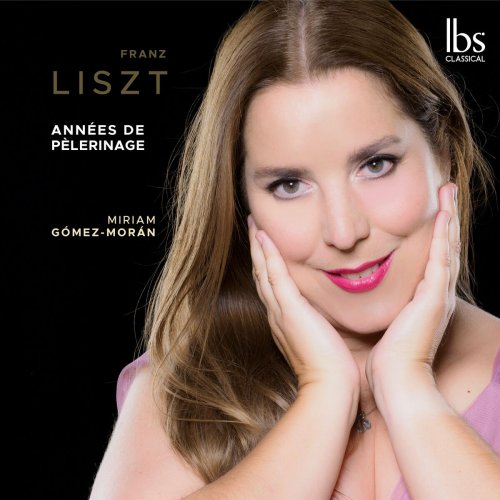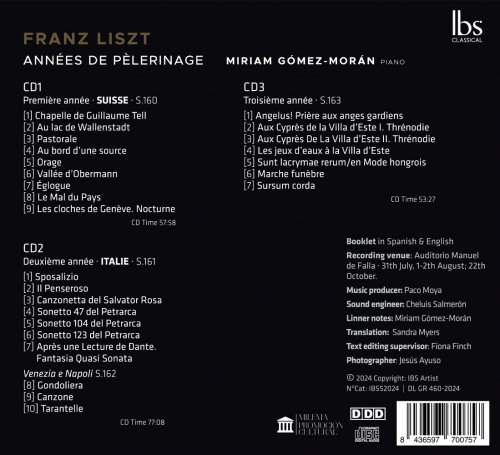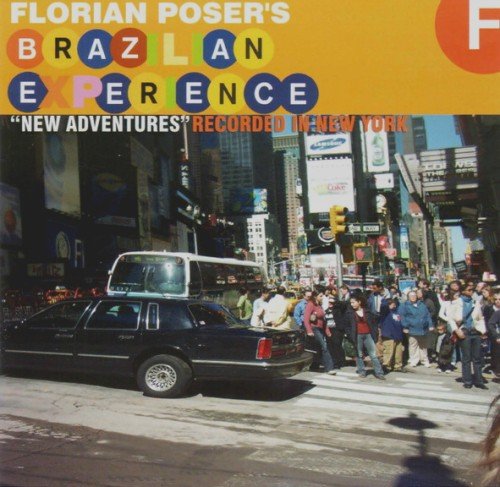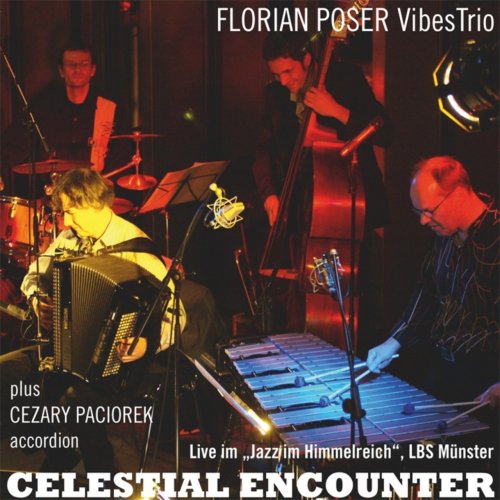Miriam Gomez-Moran - Années de Pèlerinage (2024)

Artist: Miriam Gomez-Moran
Title: Années de Pèlerinage
Year Of Release: 2024
Label: Ibs Classical
Genre: Classical
Quality: FLAC (tracks)
Total Time: 188:29 min
Total Size: 593 MB
WebSite: Album Preview
Title: Années de Pèlerinage
Year Of Release: 2024
Label: Ibs Classical
Genre: Classical
Quality: FLAC (tracks)
Total Time: 188:29 min
Total Size: 593 MB
WebSite: Album Preview

Tracklist:
CD1:
01. Chapelle de Guillaume Tell
02. Au lac de Wallenstadt
03. Pastorale
04. Au bord d’une source
05. Orage
06. Vallée d’Obermann
07. Églogue
08. Le Mal du Pays
09. Les cloches de Genève. Nocturne
CD2:
01. Sposalizio
02. Il Penseroso
03. Canzonetta del Salvator Rosa
04. Sonetto 47 del Petrarca
05. Sonetto 104 del Petrarca
06. Sonetto 123 del Petrarca
07. Après une Lecture de Dante. Fantasia Quasi Sonata Venezia e Napoli S.162
08. Gondoliera
09. Canzone
10. Tarantelle
CD3:
01. Angelus! Prière aux anges gardiens
02. Aux Cyprès de la Villa d’Este I. Thrénodie
03. Aux Cyprès De La Villa d’Este II. Thrénodie
04. Les jeux d’eaux à la Villa d’Este
05. Sunt lacrymae rerum_en Mode hongrois
06. Marche funèbre
07. Sursum corda
The nucleus of the first two suites of the cycle in question—Switzerland and Italy—along with Venice and Naples, was conceived between 1835 and 1840, a period in which Liszt was journeying through Switzerland and Italy with his lover, Marie d’Agoult. Those were years of constant travelling, not only as a result of the bohemian lifestyle that the couple was living, but also because the composer began to forge a career as piano virtuoso at a level never before witnessed. The impulses of youth, coupled with intense experiences at all imaginable levels, may be detected in the first versions of the pieces, which are surprising due to their groundbreaking ideas and the sincerity of their fully romantic expression. However, the pursuit of perfection which characterized Liszt drove him, several years later in the 1850s, to undertake an exhaustive revision of part of this material. This was the period in which he exercised the functions of Chapel Master in Weimar and in which his sentimental partner was no longer Countess Marie d’Agoult, but rather Princess Carolyne von Sayn-Wittgenstein. The works which the composer decided to incorporate into the new set were formally rounded out. They also became more orchestral in texture and acquired a harmonic language even more audacious than in the previous versions. In the First Year, Liszt included a completely new piece, Eclogue, and another which is also practically new, Storm (one of its motifs has its origin in the Nocturne from the Three Swiss Melodies, but here the similarity ends).
The Third Year was written much later, between 1867 and 1877, and presents a language which hints at Impressionism or Expressionism, and which is therefore extremely advanced for the period. While the previous suites traverse the exterior and interior landscapes in which Liszt dwelled at the moment of their creation and of their revision, the last, however, aims much further: towards the future, opening the door to a compositional and aesthetical world that wouldn´t be fully established until the beginning of the 20th century. Once again, the Hungarian master had managed to reach what none of his contemporaries had even dared to anticipate, bequeathing to posterity a music that, even today, interpolates vibrant urgency to the listener.
Miriam Gómez-Morán
The Third Year was written much later, between 1867 and 1877, and presents a language which hints at Impressionism or Expressionism, and which is therefore extremely advanced for the period. While the previous suites traverse the exterior and interior landscapes in which Liszt dwelled at the moment of their creation and of their revision, the last, however, aims much further: towards the future, opening the door to a compositional and aesthetical world that wouldn´t be fully established until the beginning of the 20th century. Once again, the Hungarian master had managed to reach what none of his contemporaries had even dared to anticipate, bequeathing to posterity a music that, even today, interpolates vibrant urgency to the listener.
Miriam Gómez-Morán


![Grises - Eveil (2025) [Hi-Res] Grises - Eveil (2025) [Hi-Res]](https://www.dibpic.com/uploads/posts/2025-12/1766127968_cover.jpg)





